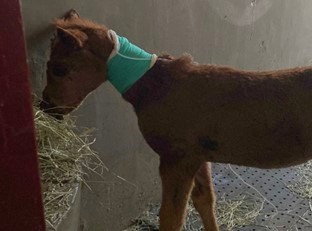Ileocecal intussusception in a foal
Case report
DOI:
https://doi.org/10.31533/pubvet.v18n11e1689Keywords:
Clostridium, enteritis, neonates, colic syndromeAbstract
Intussusception is a serious condition that can affect young animals (aged 3 to 12 months), characterized by the invagination of one part of the intestine into another, leading to lesions and intestinal necrosis. It can occur spontaneously or secondarily due to intestinal motility disorders. Enteritis is a predisposing factor and, in older foals, mesenteric arteritis is a risk factor, as well as worm infestations, including ascarids, flatworms and clostridia. Other factors include sudden dietary changes and pedunculated masses. Clinical signs typically begin with abdominal discomfort, increased heart and respiratory rates, loss of appetite, and a distended abdomen on the right side, among other symptoms. Diagnosis is made through ultrasonography, and hematological tests may reveal toxemia due to rupture or necrosis of the intestinal loops. Prompt diagnosis and treatment improve the animal's prognosis.
References
Båverud, V., Gustafsson, A., Franklin, A., Aspán, A., & Gunnarsson, A. (2003). Clostridium difficile: Prevalence in horses and environment, and antimicrobial susceptibility. Equine Veterinary Journal, 35(5). https://doi.org/10.2746/042516403775600505.
Bradley, N., Brounts, H., & Sabrina, H. (2012). Intussusception in horses: A retrospective study of 21 cases. Journal of Equine Veterinary Science, 32(4), 206–212.
Campbell-Thompson, M. (1989). Upper gastrointestinal surgery for ulcer disease in foals. The Veterinary Clinics of North America. Equine Practice, 5(2). https://doi.org/10.1016/S0749-0739(17)30593-X.
Dunkel, B., & Wilkins, P. A. (2010). Clostridial enterocolitis in horses. Veterinary Clinics of North America: Equine Practice, 26(1), 1–17.
Francellino, J. O. R., Nahum, M. J. C., Cabreira, B. S., Alves, C. A. M., Esposito, V., & Ferreira, M. A. (2015). Pronto atendimento de síndrome cólica em equinos–revisão de literatura. Revista Científica de Medicina Veterinária, Garça/SP, 25, 12.
Freeman, D. E. (2012). Gastrointestinal surgery in foals. Veterinary Clinics of North America: Equine Practice, 28(1), 167–184.
Gough, S. L., Labens, R., Quinn, C., Hughes, K. J., Slack-Smith, V., & Hilbert, B. J. (2021). Caeco-caecal and caeco-colic intussusception in two half-sibling Standardbred horses. Equine Veterinary Education, 33(4). https://doi.org/10.1111/eve.13205
Haddad, R., Corraretti, G., Simon, O., Mair, T., Sutton, A. G., & Kelmer, G. (2022). Small intestinal intussusception in horses: Multicentre retrospective report on 26 cases (2009-2020). Equine Veterinary Education, 34(12). https://doi.org/10.1111/eve.13604
Holcombe, S. J., & Shearer, T. R. (2018). Caecocolic intussusceptions in horses. In Equine Veterinary Education (Vol. 30, Issue 5). https://doi.org/10.1111/eve.12799
Leal, S. L. (2017). Diagnóstico e tratamento de cólica em equinos jovens. Veterinária e Zootecnia, 24(2), 201–209.
Machado, R. R., Previati, B. B., Bernardi, É. L., Reichert, R. C., Scapin, L., Reolon, M., Martins, D. B., Cardona, R. O., & Silva, R. B. (2011). Síndrome cólica em equino–relato de caso. In XVI SEMINÁRIO. Universidade de Cruz Alta.
Madigan, J. E. (2013). Publisher: The manual of equine neonatal medicine. In Ithaca NY (www.ivis.org), Last.
Madigan, J. E. (2017). Manual of clinical procedures in the horse. In Manual of Clinical Procedures in the Horse. https://doi.org/10.1002/9781118939956
Mair, T. S., & Smith, L. J. (2005). Survival and complication rates in 300 horses undergoing surgical treatment of colic. Part 2: Short-term complications. Equine Veterinary Journal, 37(4). https://doi.org/10.2746/0425164054529364
Mariano, R. S. G., Pacgeco, A. M., Anzé, A. L., Abilio, A. F., & Avanza, M. F. B. (2011). Síndrome cólica equina–Revisão de literatura. Revista Científica Eletrônica de Medicina Veterinária, 16–91.
Rakestraw, P. C., & Hardy, J. (2006). Surgical treatment of colic in horses. Equine Veterinary Education, 18(2), 79–87.
Reis, N. M., Santos, A. L., Silva, B. L., Venâncio, S. T. N., Boscarato, A. G., & Gregorio, M. C. (2017). Estudo retrospectivo sobre a ocorrência de cólica equina nos hospitais veterinários de Umuarama, Paraná. Revista de Ciência Veterinária e Saúde Pública, 4(2), 1–9.
Smith, L. C., & Sullivan, L. M. (2004). The effect of Clostridium perfringens type A on the gastrointestinal tract of foals. Journal of Veterinary Internal Medicine, 18(1), 40–48.
Souza, N. L. (2021). Intussuscepção ileocecal em equinos: Um estudo de caso. Veterinária em Foco, 10(3), 123–130.

Downloads
Published
Issue
Section
License
Copyright (c) 2024 Bianca Costa de Morais; Gabriela Oliveira Lamarca da Silva ; Micaela Da Silva Carrijo, Ana Luiza Bernardes Pavan, Livia Maria Dias de Sá, Luccas Salmazo Maccarini, Vitor Foroni Casas

This work is licensed under a Creative Commons Attribution 4.0 International License.
Você tem o direito de:
Compartilhar — copiar e redistribuir o material em qualquer suporte ou formato
Adaptar — remixar, transformar, e criar a partir do material para qualquer fim, mesmo que comercial.
O licenciante não pode revogar estes direitos desde que você respeite os termos da licença. De acordo com os termos seguintes:
Atribuição
— Você deve dar o crédito apropriado, prover um link para a licença e indicar se mudanças foram feitas. Você deve fazê-lo em qualquer circunstância razoável, mas de nenhuma maneira que sugira que o licenciante apoia você ou o seu uso. Sem restrições adicionais
— Você não pode aplicar termos jurídicos ou medidas de caráter tecnológico que restrinjam legalmente outros de fazerem algo que a licença permita.




